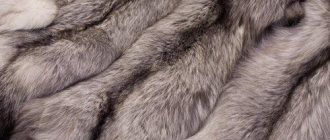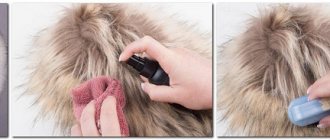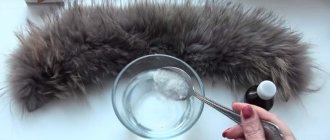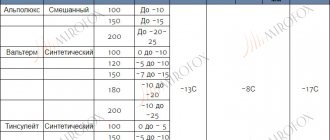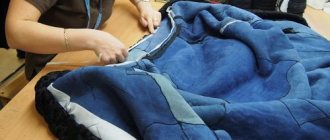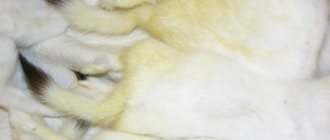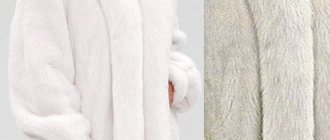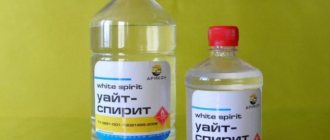One of the most favorite types of warm winter clothing for most women is, without a doubt, a mink coat. They want this luxurious product to reliably serve for as long as possible and therefore they are very upset if, once again, when taking it out of the closet, they notice the inevitable traces of time, the results of moth tricks or some other unpleasant damage and defects.
If purchasing a new fur coat is not currently in your plans due to certain circumstances, you can choose a much simpler and less expensive way - to update your favorite mink fur product yourself. Moreover, such restoration can be easily carried out even in familiar home conditions. A reasonable question arises: how to restore a mink coat.
Beautiful mink coat
Taboo when cleaning fur
- Fur cannot be washed! If the fur (the skin that holds the fur) gets wet, it can become rough and cracked. In this case, the product becomes deformed and becomes bald.
- Fur should not be dried with a hairdryer, on a radiator or in direct sunlight! Only possible outdoors or in a well-ventilated area.
- Fur should not be ironed! Even from the inside out.
- Fur cannot be cleaned with household chemicals to remove rust, washing powders with enzymes, or bleaches.
Before using any other product, test it on a small, inconspicuous area of the product. For example, under the arms.
What not to do at home
It is prohibited to carry out the following experiments with fur items on your own:
- wash and remove stains with washing powder or detergents;
- dry the fur over heating devices or near a fire (it should be dried naturally in a thoroughly ventilated area);
- clean the fur with a vacuum cleaner;
- Smooth it with an iron - the fur will even out on its own.
It is better to clean and dry fur products in spring and summer, when it is warm and natural drying is possible. It is also not recommended to dry the fur in direct sunlight, as it will lose its natural color.
How to get rid of dust
Even in a well-closed case, a fur coat or vest can become dusty. Therefore, before storing a fur item for storage, and also before wearing it, freshen it.
Spread a damp white cotton sheet on the floor. Place the fur coat on top and beat it thoroughly, first on one side and then on the other. After that, hang it on a hanger and comb it.
If the fur is tangled and matted, spray the item with warm water from a spray bottle and let it dry. Then comb. The pile will fall into place. For the same purpose, you can carefully walk over the fur with a steamer.
Features of cleaning light-colored mink
If a black or brown mink coat is cleaned once every 1-2 seasons, then snow-white items will have to be refreshed much more often. The bottom of the product, collar, sleeves, and pocket entry area may become dirty after just a few wears. Regular fabric clothes can be easily washed in the washing machine by adding bleach. With fur products, not everything is so simple; it is recommended to use one of the following products:
- natural absorbent substances (semolina, potato or corn starch) - suitable for cleaning the entire product;
- alcohol, vinegar essence, hydrogen peroxide - effectively remove yellow greasy stains;
- Shampoos for washing hair or animals - suitable for washing the entire product or individual areas.
As a rule, starch is most often used. It is finely ground, the powder is easy to sprinkle on the lint and is also easy to remove after cleaning. If it turns dark gray or brown during processing, it is better to repeat the procedure again.
A very dirty vest or fur coat can be cleaned in another tricky way. Cover the darkened areas with a thin layer of starch, and then spray with a soap solution from a spray bottle. Wait until the composition dries, clean with a brush or comb with an animal slicker.
How to restore shine to fur
To make your fur coat or collar sparkle again in the sun, treat it with a solution of lemon juice or table vinegar (not essence!).
Dilute lemon juice or table vinegar in water in a ratio of 1: 1. Using a sponge or soft natural cloth, treat the fur. It is important that the sponge or rag is wrung out well. The pile should not be wetted, but rather wiped.
When the product dries, comb it. The effectiveness of this product is especially noticeable on mink.
Another way to restore shine to fur is to use walnuts. Grind the kernels, wrap them in gauze and rub the fur. The released nut oil will refresh the appearance of the product.
In most cases, the measures described - knocking it out and returning the shine - are enough to make a fur coat, hat or vest look like new. But more serious problems can arise with natural fur. It may turn yellow, become greasy, or become stained.
How to clean dark fur
For fur products of dark shades, ordinary bran and walnuts are perfect. The bran is heated in the oven to 60-70 degrees. Then they gently rub them into the fur, collecting all the dirt. The thing is shaken off. The nuts are crushed and the resulting powder is tied into a gauze cloth and folded in half. Use this swab to wipe the fur in the direction of the villi. Walnut oil nourishes the hair well, giving it a lively and effective shine. At the end of cleaning, the product is combed with a special bristle brush.
How to get rid of yellowness
Over time, light fur, as well as fur with white hair at the tips (silver fox, chinchilla and others) acquires a yellow tint. The product immediately loses its presentability.
There are several ways to clean fur from yellowness.
- Dissolve 1 tablespoon of table salt and ½ tablespoon of ammonia in a glass of warm water. Apply the solution using a well-wrung out soft cloth. Dry and comb.
- Dissolve 1 tablespoon of hydrogen peroxide in a glass of warm water. Apply the solution to the product, let dry, and comb.
- Dissolve 1 tablespoon of pet shampoo in a glass of warm water. Beat the foam and apply it to the pile using a sponge. After 5 minutes, remove the foam with a sponge or cloth soaked in clean water. Dry and comb.
Products with short pile can be wiped both with and against the wool. On long fur, cleaning agents are applied according to its growth, after which the pile can be ruffled.
When removing greasy deposits and stains, the color of natural fur is also important.
Things to remember
- Methods for cleaning dark fur: soap suds; river sand; sawdust and medical alcohol; medical alcohol and table salt.
- Methods for cleaning light fur: talc; gasoline and starch; potato starch; carpet beater (cracker); dog shampoo; hydrogen peroxide; wheat bran; semolina; vodka and vinegar.
- Methods for cleaning the lining: tear off and wash; wash on the spot.
- Rules for caring for the item: dry and wet wash; natural drying; no sunlight; protection against moths; combing.
How to clean white fur
niknikpo/Depositphotos.com
Starch, talc and semolina help fight grease and greasy stains on white fur. They absorb dirt and unpleasant odors.
Take starch (semolina or talcum powder) and pour it onto the contaminated area. Using a soft brush, distribute the substance between the fibers or gently rub the fur with your hands, as if you were washing. Shake the product well to remove any residue.
The dirtier the fur, the darker the starch, talc or semolina will be. The procedure must be repeated several times until the substance stops getting dirty.
It’s even more effective if you heat starch, talc or cereal before cleaning. This can be done in a dry frying pan or in the microwave.
It is important to remove all remnants of the product, otherwise it will become food for moths. Therefore, the product can not only be shaken well, but also vacuumed with a low-power vacuum cleaner. For example, the kind that is used to clean the keyboard.
When to clean fur
Cleaning of fur products is resorted to in the following cases if:
- there is dirt and dust on the surface;
- the uniform color structure is lost;
- there are particles of debris between the hairs;
- tangled lumps are formed and the ends of the hairs are cut.
Cleaning fur yourself is only possible if it is not too dirty. Otherwise, of course, it is better to find a specialized dry cleaner and entrust your fur to it.
How to remove stains from fur
Stains on fur clothing can have different natures and origins. For example, natural suede bags readily give off the color of fur when worn on the shoulder. You can get dirty with sauce when you eat on the run, or make a blot with a stationery pen.
You can remove stains from dark fur using gasoline (white fur will turn yellow). Refined gasoline with a high octane number. Sometimes it is applied in its pure form, but more often it is mixed with starch or washing powder without enzymes to the consistency of sour cream. A couple of minutes after application, the mixture should be removed with a sponge soaked in clean water, and the product should be dried and combed.
Stains from light fur can be removed using acetone or alcohol, also by mixing liquids with starch or baking soda.
The stronger the dye and the older the stain, the more difficult it is to deal with it at home. If the above methods do not work, do not experiment: take the fur coat to the dry cleaner.
Cleaning according to traditional recipes
There are two ways to clean a mink coat at home:
- dry;
- wet.
The first one can easily cope with fresh and shallow dirt. And the second is intended exclusively for old stains.
Dry processing
This is a safer procedure; suitable means can be found in every home to carry it out. They will absorb dirt, remove small yellow spots and return the fur coat to its original noble appearance.
- Semolina . You can clean a fur product using this unique abrasive product. It will help if the fur coat is covered with dust, the noble color has faded, and the natural shine of the fur has disappeared. The product should be used as follows: lay the coat on a table or other flat surface and sprinkle with a thin layer of cereal, paying special attention to pockets and sleeves, shake vigorously several times and hang on hangers. Next, you should thoroughly but gently brush the fur with a brush with metal bristles.
- Talc . This product is indispensable if you need to remove dust and other contaminants from the pile, as well as moisture or any odors. When working with talc, it is advisable to wear gloves to keep your hands clean and dry throughout the procedure. The fur coat must be buttoned up, leveled on the table and sprinkled with talcum powder. Rub the powder into the pile with light movements. After a few minutes, shake the fur coat well so that no particles of talc remain in the fur, and comb it with a brush or comb with sparse teeth.
- Potato starch . This product stands out from everything that can be used to clean a mink coat. Usually it is used after the end of the next winter season to remove some minor dirt. Starch is especially good for cleaning white mink products.
The sequence of actions for all dry cleaning options is the same. If after the procedure the bulk product turns out to be dark, you should repeat the action again.
Features of the wet method
This method can be used to remove old dirty stains. It is based on the use of aggressive ingredients that require caution and attention, otherwise you can ruin an expensive item.
Before cleaning, the fur coat should be hung on hangers and left in an upright position. And when finished, comb with a brush and dry well. It is recommended to use the following means:
- A solution of gel, shampoo or soap. It is done depending on the volume of the fur coat: the wider and longer it is, the more water and detergent will be required. First, add 100 ml of laundry soap, shower gel or shampoo to a container with warm water. Wipe the fur on the problem area with a sponge soaked in this solution, and the hairs should be moistened from tips to roots. String pieces of cotton wool onto the teeth of a comb and comb the treated area. This method will not only clean the fur of dirt, but also restore it to its former shine.
- Petrol. To clean a dirty collar, it is best to use aviation gasoline or lighter fluid. This is a difficult area that usually contains stains from cosmetics. To prepare the solution, mix gasoline and burnt magnesia until mushy. Apply the resulting product to the contaminated area and wipe the fur against the lint. Dry, then comb out the pile and wipe with 5% vinegar.
- Ammonia and salt. Dissolve a tablespoon of salt in a glass of warm water, and add half a teaspoon of ammonia. Moisten a soft cloth in this mixture and carefully clean the fur coat.
- Alcohol or vodka. It’s also a very effective way to make your fur coat look chic again. Add a few drops of alcohol or vodka to half a glass of hot water and stir. Moisten a cotton swab in this mixture and clean the stains with it in the direction of the pile.
- Vinegar. The working solution is made up of water and vinegar in a ratio of 5:1. Soak a cotton pad in it and wipe the fur with light movements. After drying, comb the fur coat thoroughly.
- Hydrogen peroxide. It does not need to be diluted; you can use it directly from the bottle: pour it onto a cotton swab and immediately treat the stained area. If a dark mark remains on the tampon after the first treatment, it must be changed and the procedure repeated. Next, dry and comb.
- Ammonia. This product can clean both light and dark fur. It effectively removes stains as well as various odors. After it, the fur coat again acquires its original shine. To prepare the solution you will need one part ammonia to three to four parts water.
Before using products recommended for wet cleaning, it is advisable to test them on a piece of fur. This precaution will allow you to avoid unpleasant surprises.
Soft fur even after washing
You cannot wash fur items; you must use dry cleaning services. Cold water with powder will trigger the process of emulsification of fat; it will turn into a solution under the influence of the active substances included in the detergent. The fibers will become dry because they will lose their lubricant. This process is reversible.
Mink fur washed in hot water, that is, at temperatures above 40°C, cannot be restored. The protein in the fibers is destroyed, and it will not be possible to soften the core after washing again. Neither castor oil, nor glycerin, nor the services of professionals will help here.
What are the most common types of damage to fur products?
As a rule, mink coats faithfully and reliably serve their happy owners for fifteen to twenty seasons. However, due to insufficient storage of these products or some other unfavorable factors, there is a high risk of premature occurrence of unwanted damage and defects. The most common and common types of problems include:
- divergence of seams on a fur product;
- the appearance of characteristic abrasions in the area of sleeves, collars, pockets;
- skin tears in various areas of the mink coat.
All these types of damage are very serious and therefore require thorough restoration - for example, a complete recut and change in style. By carefully looking at the photos and videos, you can easily learn how to restore a fur coat. The main thing is to have the necessary high-quality tools at hand and not be afraid to modify your usual product. After all, time does not stand still, and completely new fashionable models and styles of mink coats are constantly appearing.
Of course, in order to properly and efficiently update a fur product, you will need to spend a lot of time, as well as be careful with every movement. Thus, not only will it not lose its charm, but it can also become even more attractive.
What you need to repair or restore a fur coat
If the item is subject to restoration, you need to think about the material for repair. A long fur coat will make a sheepskin coat, and there will be enough fur for restoration. Shortening a long fur coat is the best option, since its floors often get dirty and worn out. The “trapezoid” model is best suited for recutting – it has a lot of fur, which allows you to get creative with patterns.
For minor repairs, you can take the fur from the underside of the turn-down collar or cuffs, replacing it with natural or artificial leather, suede, or drape of a suitable color. To replace the collar, cuffs and hems, you can choose fluffier fur. You can use a child's fur coat, or buy tanned skins at a fur store. The combination of fur and leather looks good. A fur coat can be transformed by trimming the edges of the sleeves, pockets, and top shelf with strips of leather.
Fur restoration: 5 steps
- Now you can take on the restoration. Let's consider the option of remaking an old fur coat into a sheepskin coat. Carefully inspect the product to identify areas that require repair. These could be abrasions, bald spots, loose seams, or skin breaks. Calculate the amount of fur required for restoration. Taking this into account, mark the expected length, adding 3-6 cm to the allowances.
- Open the lining at the bottom of the fur coat and sleeves, as well as along the shelves. If the lining is worn, it must be replaced. Turn the fur coat inside out, and on the wrong side, circle the areas that require repair with chalk. Using a sharp furrier's knife or scalpel, carefully cut through the flesh along the metal ruler, without touching the fur.
- From the cut bottom of the fur coat, first remove the large parts: stripes for the shelves, collar and cuffs. Use the remains to restore minor flaws. To make the sewn pieces of fur invisible, select them according to the shade and height of the pile, pay attention to the direction of the hair. For the sleeves, cut out the stripes in the transverse direction, for the vertical edges of the shelves, cut out the longitudinal stripes, and manually sew them together. For thick leather, it is better to use a faceted needle. You will need a thimble and strong threads to match.
- Place the fur coat and the prepared part on the table with the fur facing down, align the edges to be sewn, and mark the joining lines with chalk every 5 cm. At these points, connect the parts with several stitches. Sew the parts together with an overcast stitch over the edge using even stitches every 2–4mm. The seam should pull the edges together. Straighten the seam and tap it from the inside out with a wooden hammer, or iron it with the rings of scissors.
- Then you can move on to the worn areas. Carefully cut out the area of the abrasion. From the remaining pieces, select a flap that is suitable in direction, color, and height of the pile. Open the insert with a 2mm seam allowance. Sew the insert in by hand, first attaching it with stitches to the product in several places. Straighten the seam.
Rules for cleaning and storing products
When cleaning mink fur, there is a high risk of being careless or not taking into account the characteristics of the substances used. Actions that are undesirable when caring for an expensive product:
- Washing coats is strictly prohibited. Under the influence of detergents and water, it will lose its shape, the skin will become rough and dry.
- Do not use a hair dryer when cleaning wet.
- Under no circumstances should an iron be used during the drying process. The product will retain its natural shape if you use regular hangers.
- You should clean your mink coat only when necessary. Too frequent procedures may cause fur shedding.
To avoid the problem of how and how to clean a mink coat at home before each winter season, you need to follow several rules. They are quite simple:
- You cannot store a fur coat in a plastic bag so that the pile does not become electrified and oxygen deficiency does not form;
- Before long-term storage of products, it is recommended to treat cabinets with special products that will protect the fur coat from pests;
- you can stuff your sleeves with newsprint: moths don’t like the smell of printing ink;
- Before storing a mink coat, you need to ventilate the room and put a bag of incense in the closet;
- Mink fur should not be sprayed with perfume to avoid stubborn stains;
- you should give up the habit of carrying a bag on your shoulder or on your arm: this is a sure way to dry out the fur.
For today, that’s all I wanted to say about how to clean a mink coat at home. And if you follow simple rules and provide the fur coat with proper care, then this expensive and beautiful thing will last a long time. It is advisable to monitor the condition of the mink coat in the summer.
Advice from Mobile Tailor
Before starting work, you can seek advice from the Mobile Tailor studio, where experienced craftsmen will be happy to help you assess the scope of work, give important recommendations, and, if necessary and at your request, provide qualified assistance. We guarantee the quality of all types of work performed by our specialists. Your old things are waiting to be transformed to delight you for many more seasons.
<< Back to Lifehacks Studio
Defects on fur products
When is fur coat restoration necessary? The following signs indicate this:
- the edges of the sleeves are frayed;
- the fur has rubbed off on the pockets and at the bottom of the product;
- the fur coat is torn (along the seam or along the skin);
- the lining is worn out;
- bald patches appeared in any area;
- The fittings are damaged: buttons, hooks, loops are torn off, along with small areas of fur.
In addition, restoration of a fur coat may include changing the color, style, length, adjusting to the figure or a complete alteration.
Often such work involves the use of additional materials: similar fur for inserts, or completely different fur for a new collar, sleeves, or trim. All this affects the cost of rework. The final price for repairing a fur product can only be found out when the technician examines the item and determines the degree of wear, and also listens to the client’s wishes.
If your fur coat comes apart at the seam: what and how to do
Get to the unraveled seam from the wrong side of the product. If the lining is sewn on, back it up. If it is not stitched, bend it back. Carefully bring the edges together with the fur inward, and sew along the entire opening with a furrier's stitch. This is done like this:
- pass the needle through both edges
- pull the thread
- then throw the needle through the cut
- insert the needle again into the first puncture site
- tighten the thread.
The next puncture should be at a distance of 2-3 mm on the side opposite to the first (on the side where the needle came out). Repeat the stitch formation process. As a result, a line with intervals will appear on both sides. After this, sew up the lining (if it was sewn) and comb the fur.
Attention!
- During the sewing process, carefully ensure that the fur flaps do not move relative to each other.
- Avoid the formation of bubbles or depressions.
- Work on a hard surface.
- Control the direction of pile growth when repairing your fur coat yourself. If you can maintain the natural pattern of the fur, no one will guess that the fur coat was sewn up.
If the fur coat comes apart at the seams a short time after its purchase, then most likely you were sold a low-quality product. In this case, try to first contact the store with a demand to either return the money or exchange the product. It’s better to still demand the money back, since most likely the entire batch of fur coats turned out to be of poor quality.
